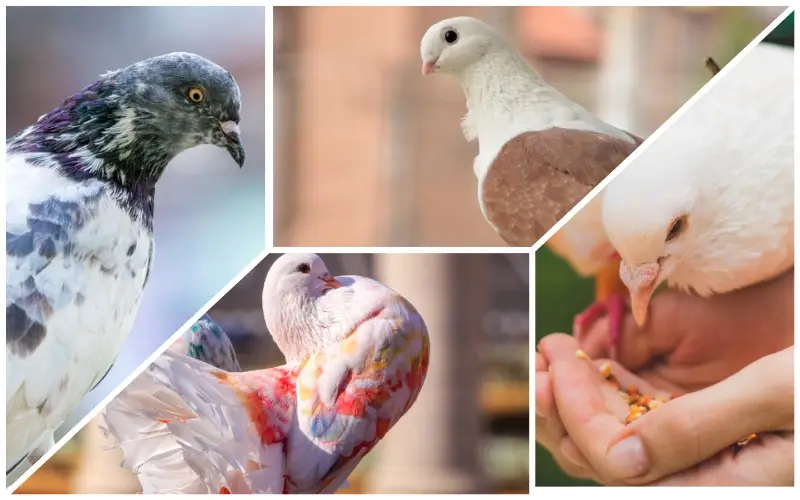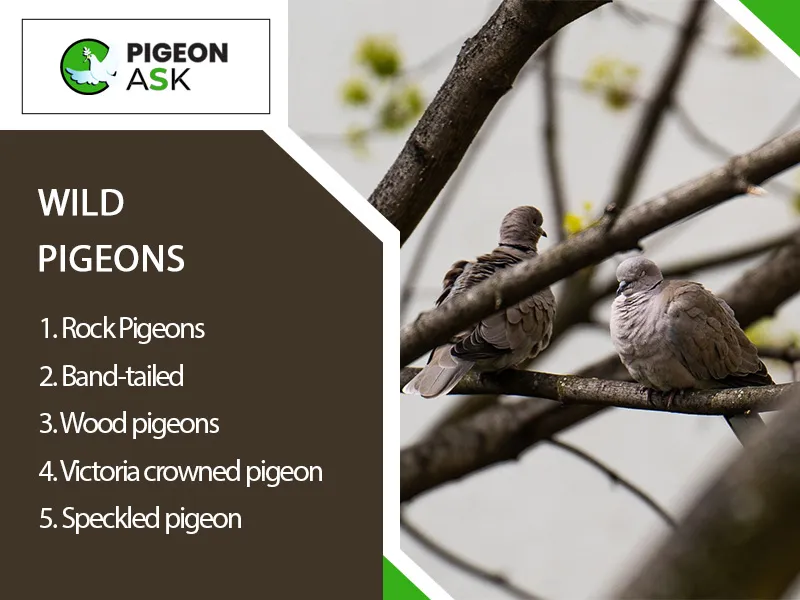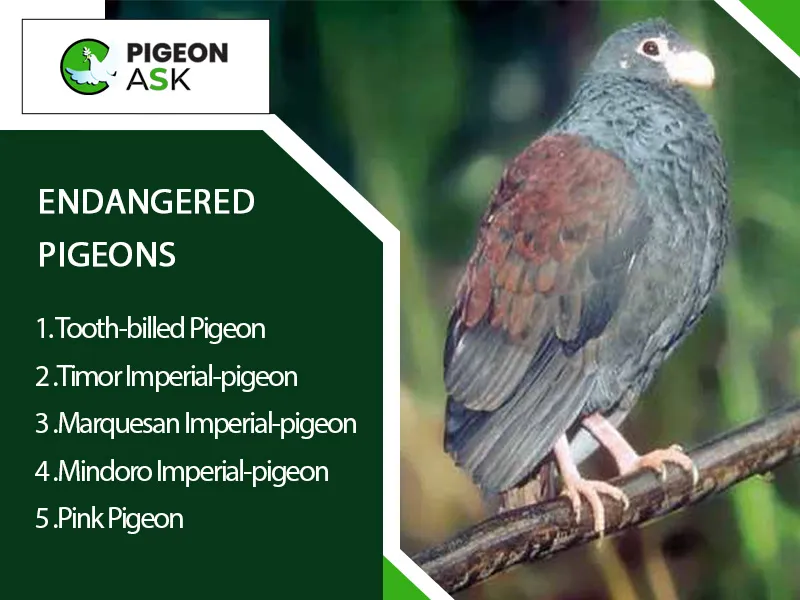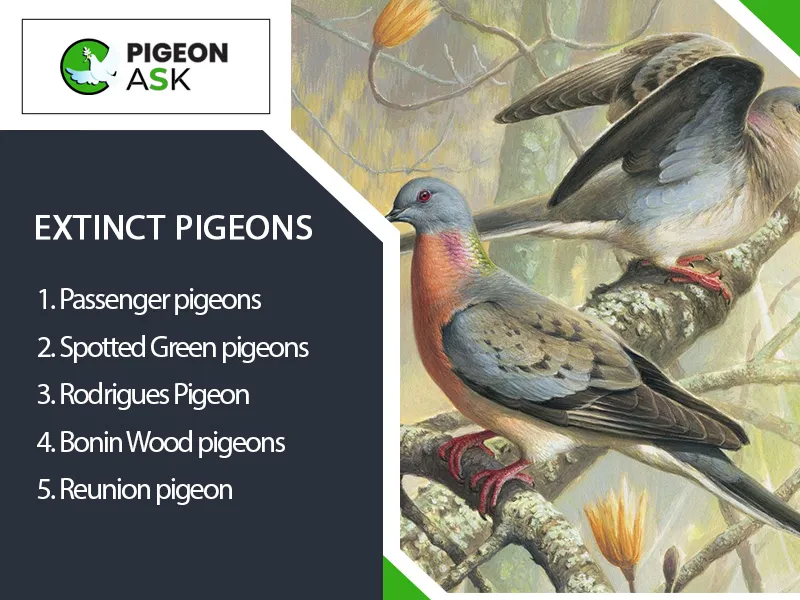Types Of Pigeons Type:
Domestic And Wild
Surprisingly, there are over 300 varieties of pigeons. Aerial skill is a characteristic of racing homers and tumblers. Fancy pigeons easily draw attention because of their colorful plumage and remarkable vision.
The multicolored carpet of bird life reveals the pigeon world with rich complexity. Pigeons are seen from the era of ancient Mesopotamia to the present day.
However, how many species of pigeons fly around in our sky? Surprisingly, there are over 300 varieties of pigeons. Aerial skill is a characteristic of racing homers and tumblers. Fancy pigeons easily draw attention because of their colorful plumage and remarkable vision.
Along with utility breeds, large King Pigeons and bulky Giant Runts are specifically created to produce food. I will describe the pigeon types, and I’ll explain why wild birds are different from feral ones as well as extinct and endangered ones.

Let’s explore!
Domestic Pigeons
The earliest domesticated bird is the domestic pigeon, portrayed as early as 4500 BC in Mesopotamia. Domestic pigeons were brought into the United States from Europe in 1600. It has been used for food, and it was a messenger in history.

Let’s uncover more information about them in three categories-
01. Fliers
“Flier pigeons” are another group that are excellent at flying. They are capable of gliding at unbelievably high altitudes, and even life-threatening acrobatic moves in mid-flights. Fliers are specially bred for the length of time they fly. Some examples are-
Racing Homer: One of the newest, but most popular domesticated pigeon breeds is Racing Homer. This breed has better speed and improved homing instinct.
Tumbler: The tumbling ability of Tumbler Pigeons originated from the fight to survive long centuries ago. These Pigeons attract crowds today with midair aerobatics.
Roller: This species performs both one-and-a-half-turn somersaults in the air. They are different from Tumbler Pigeons as they can perform multiple flips during their flight.
02. Fancy
As the name sounds, Fancy pigeons come in specified sizes and colors. These birds are renowned for their many different shades such as white, brown, gray, and black. They are healthy and disease-free and have a life span of almost 10 to 15 years.
These birds have eyes usually orange or red. Their vision covers up to 25 miles. They are Seen in livestock shows, and fairs. Here’s the mentionable name of fancy pigeons-
Fantail: The Fantail pigeon (a breed of fancy bird) has a magnificent fanned-out tail, and 30 to 40 feathers—twice the usual number in its family. It comes from areas such as Pakistan, India, China, and Japan.
Some have feather mutations called the Silky variety, which gives a lace-like effect to their tails.
Jacobin: This is an Asiatic bird that originated in India and is defined by the elegance of its hooded head covering. Jacobin, called after the French monks with hoods, was developed in 1500 and is still attractive to breeders.
Having soft feathers, impaired vision caused by the hood, and a range of shades, Jacobin pigeons are tall and thin without losing their charm.
Helmet: The Helmet pigeon is an incredibly old fancy breed that probably developed in Persia over five hundred years ago. They have a white full body with a colored cap looking like a helmet. Helmets have been popular since the 1950s, especially in America, Canada, and Australia.
03. Utility Breeds
The is a group of breeds that specialize in meat production, offering squab. Being bred for fast growth and prolificacy, they prefer productivity over show criteria. Some utility breeds are-
King pigeons: The King Pigeon is a household breed developed in the US through selective pigeons to meet practical needs like meat production and exhibition.
King pigeons are Famed for their majestic appearance and giant size. They have an average weight of about 570 grams though sometimes reaching up to a whopping 900 gm.
Giant Runt: As a popular breed in the United States, the Giant Runt Pigeon is one of the largest types of domesticated pigeons. They first became popular in the mid-nineteenth century and made appearances at exhibitions over time through selective breeding.
Giant Runt is characterized by its ability to produce squab because it has a wide body and long head as well as an oval-shaped skull.
Carneau: The large and robust Carneau Pigeon is worth mentioning as one that has been bred through selective breeding practice in Northern France, and Southern Belgium. They are the second largest domesticated pigeon only after King Pigeons.
Carneau Pigeons depict grace because of their slender, well-shaped build, noticeable head, and powerful wings. Characterized by distinct colors and patterns, such as white or red, they are very famous among their competitors.
Wild Pigeons
Rock pigeons, also known as wild pigeons or rock doves, are the forefathers of domestic ones. Such birds are known in scientific terms as Columba livia.
Native to Europe, North Africa, and South Asia, wild pigeons have been the most successful settlers in various parts of Earth, especially urban areas. They have grayish plumage, a wide black tail band, and loud cooing sounds.

Within its natural environment, the wild pigeon breeds on cliffs and on ledges that are near to sea, and they feel secure and have suitable crevices for nesting.
It is quite common to know that wild pigeons find food almost everywhere, vegetables, grains, and invertebrates. Wild pigeons are one of the key species in ecosystems as they serve as seed dispersers and also provide food for some predators.
Although they are somewhat comparable to their tame counterparts, wild pigeons tend to be less wary and have kept certain natural behaviors such as a powerful homing instinct.
There are numerous types of wild pigeons available. Here I’m giving some notable examples-
- Rock Pigeons
- Band-tailed
- Wood pigeons
- Victoria crowned pigeon
- Speckled pigeon
Domestic vs Wild pigeons
Significantly, domestic pigeons are big and designed for some purposes, whereas wild pigeons are small and retain their original appearance. And undomesticated wild doves with strong survival genes have a very potent disease immunity.
On the other hand, domestication results in specialization as some breeds are created for meat production, decorative value, or used in messenger services. This specialization leads to changes in flight performance and the quality of meat.

Besides, domestic pigeons fly less than wild ones because of their breeding and confinement. As for diet, both the wild and domestic pigeons prefer mostly agricultural plants including corn beans, wheat grains, etc.
Although wild pigeons are used for uncooked meals, domesticated ones respond easily to cooked or pellet combined feed presented in cultivated reared flocks.
Feral Pigeons
By name, they are wild but Feral pigeons are actually the descendants of domesticated rock pigeons. They survived globally in agricultural and urban environments. The number of these pigeons increases rapidly in cities, up to 15,000 per square kilometer.
They have a maximum life span of 3 to 5 years in the wild and thirty-five years when reared. Feral pigeons are found everywhere.
Endangered Pigeons
The endangered pigeons are a species that has a considerable risk of extinction in the wild.

They are threatened due to the loss of habitat, small population, and human activities like overhunting. Here are some examples of Endangered pigeons according to IUCN-
- Tooth-billed Pigeon
- Timor Imperial-pigeon
- Marquesan Imperial-pigeon
- Mindoro Imperial-pigeon
- Pink Pigeon
Conservation measures like habitat protection and breeding should be done to keep endangered pigeon species from extinction.
Extinct Pigeons
Some pigeons were reduced by overhunting and habitat destruction until extinction. Industrialization for cheap meat motivated hunting them more during the 19th century.

The birds were netted shot and even subjected to burning sulfur for trade. Let’s learn the names of extinct pigeons-
- Passenger pigeons
- Spotted Green pigeons (Liverpool pigeons)
- Rodrigues Pigeon
- Bonin Wood pigeons
- Reunion pigeon
Unfortunately, there were no protective legal restrictions in place against the species’ destruction which caused their fast devastation during 1870-90. Conclusively, the last reported wild passenger pigeon was shot in southern Ohio in 1900.
Frequently Asked Questions
Here are a few more additional questions you might be asking now regarding their types.
01. What is the most common type of pigeon?
The most common type of pigeon is the Rock pigeon. It can be found in every region.
02. What is the rarest pigeon species?
Soccoro Dove is arguably the rarest pigeon. Followed by Pink Pigeon.
03. Which pigeon is best for home?
Racing Homers, Kings, Fantail, etc. all are best to raise at home.
From domesticated pigeons in Mesopotamia to contemporary Homer, Fancy varieties, and Utility breeds, these birds portray human creativity. Be they performing death-defying somersaults in the air or just standing puffed up with vanity inside their domesticated cages, pigeons still manage to amaze us.
The Fliers reach heights, the Fancy breeds illustrate beauty, and the Utility birds symbolize productivity.
However, these tiny creatures should be protected. As I mentioned, some pigeons became extinct and some are endangered because of overhunting population size, and habitat loss.
References
- https://www.britannica.com/animal/pigeon
- https://www.si.edu/spotlight/passenger-pigeon
- https://worldrainforests.com/endangered/charts/birds-doves.html
- https://www.pigeoncontrolresourcecentre.org/html/about-pigeons.html
